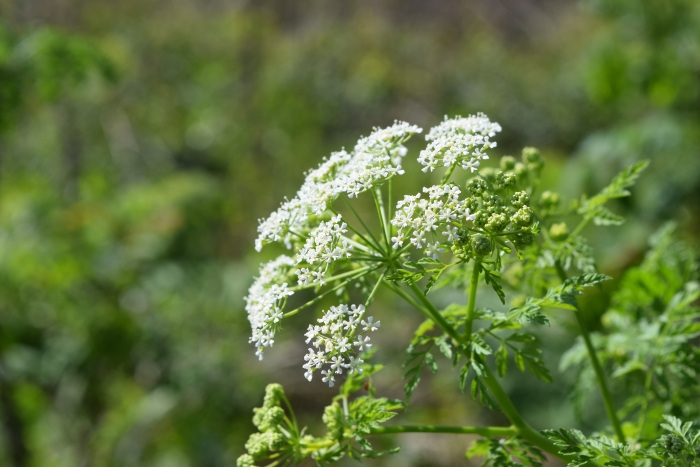Poison Hemlock
(Conium maculatum)
Poison Hemlock (Conium maculatum)
/
/

Djtanng
CC BY-SA 4.0
Image By:
Djtanng
Recorded By:
Copyright:
CC BY-SA 4.0
Copyright Notice:
Photo by: Djtanng | License Type: CC BY-SA 4.0 | License URL: https://creativecommons.org/licenses/by-sa/4.0 | Uploader: Djtanng | Publisher: Wikimedia Commons | Title: Poison_Hemlock.jpg | Notes: User created page with UploadWizard |

































































Estimated Native Range
Summary
Conium maculatum, commonly known as Poison Hemlock, is a biennial herb that is native to temperate regions of Europe, North Africa, and parts of Asia, often found in riparian zones, along riverbanks, and in moist waste areas. It can grow to heights of 1.5–2.5 meters (5–8 feet) with a smooth, hollow stem that is characteristically marked with red or purple streaks on the lower half. The plant is notorious for its toxicity, with all parts being poisonous, particularly the seeds and roots. Poison Hemlock has a distinctive, generally unpleasant odor that can be carried by the wind. It features small white flowers arranged in umbrella-like clusters, blooming in the summer and adding to its deceptive appearance, as it resembles some non-toxic plants.
The plant’s rapid growth and ability to reach up to 8 feet tall make it a concern for gardeners, as it can outcompete native vegetation. Despite its toxicity, it has been used historically for medicinal purposes, but extreme caution is advised due to its poisonous nature. In cultivation, it requires full sun and adapts to a range of soil drainage conditions. However, its invasive potential makes it a problematic plant in areas like California, where it can disrupt local ecosystems. Gardeners should be aware of its invasive status and avoid planting it in regions where it poses an ecological threat.CC BY-SA 4.0
The plant’s rapid growth and ability to reach up to 8 feet tall make it a concern for gardeners, as it can outcompete native vegetation. Despite its toxicity, it has been used historically for medicinal purposes, but extreme caution is advised due to its poisonous nature. In cultivation, it requires full sun and adapts to a range of soil drainage conditions. However, its invasive potential makes it a problematic plant in areas like California, where it can disrupt local ecosystems. Gardeners should be aware of its invasive status and avoid planting it in regions where it poses an ecological threat.CC BY-SA 4.0
Plant Description
- Plant Type: Herb
- Height: 3-7 feet
- Width: 1-2 feet
- Growth Rate: Rapid
- Flower Color: White
- Flowering Season: Summer
- Leaf Retention: Deciduous
Growth Requirements
- Sun: Full Sun
- Water: Medium
- Drainage: Slow, Medium, Fast
Common Uses
Bank Stabilization, Showy Flowers, Water Garden
Natural Habitat
Native to temperate regions of Europe, North Africa, and parts of Asia, often found in riparian zones, along riverbanks, and in moist waste areas
Other Names
Common Names: Hemlock, Wild Hemlock, Carrot-Fern, Fool’s-Parsley, Poison-Hemlock, Spotted-Hemlock, Spotted-Parsley, Deadly Hemlock, Poison Parsley, Common Poison-Hemlock
Scientific Names: , Conium maculatum, Conium cicuta, Conium maculatum var. viride, Conium maculatum var. leiocarpum, Conium maculatum subsp. leiocarpum, Conium croaticum, Cicuta major, Conium ceretanum, Conium sibiricum
GBIF Accepted Name: Conium maculatum L.